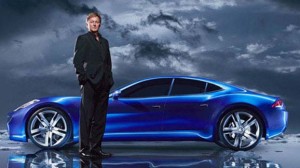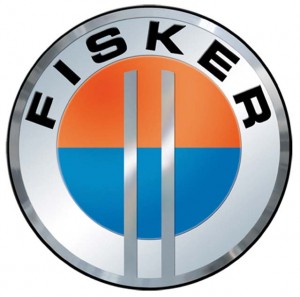
Danish-born designer Henrik Fisker believes his eponymously-named start-up, Fisker Automotive, can revolutionize the auto business.
He’s best known as a designer, the pen behind gracefully muscular concept and production vehicles like the BMW Z8 roadster and the Aston Martin DB9 sports car. But Danish designer Henrik Fisker could eventually wind up better known for a small, eponymously-named California start-up company with some very big plans.
In an unexpected move, Fisker left Ford’s then parent company, Ford Motor Co., in 2005, to set up his own firm in Southern California. Initially, he and his partners planned to revive the lost art of custom coach building, taking platforms from luxury makers like BMW and Mercedes-Benz and retrofitting them with limited edition bodies and interiors. But a couple years later, the designer shifted gears again.
Next June, Fisker Automotive will deliver the first of an all-new series of vehicles dubbed Karma, using plug-in hybrid powertrain technology. Plug-ins go a step beyond conventional hybrids, like the Toyota Prius, with oversized battery packs permitting a motorist to commute or run errands largely on electric power alone. But Fisker insists that’s just the beginning. Late last month, he announced plans to use a $528 million federal loan to purchase an abandoned General Motors plant, in Wilmington, Delaware, to produce a second line of plug-ins which the company expects to export around the world.
Can a Danish sports car designer challenge the big names in the auto industry? TheDetroitBureau.com Publisher Paul A. Eisenstein spoke to Henrik Fisker about his company, his plans and his challenges.
TheDetroitBureau.com : We’ve been hearing a lot about Fisker Automotive, lately, but why don’t we begin by asking you about the recent news and your most immediate plans?
Fisker: We’re still finalizing the Fisker Karma to get it ready for launch. As we worked on Karma we were always preparing for a second, lower-cost vehicle, and the Department of Energy loan made it possible to hit the gas full-speed on Project Nina. We’re going to be moving fast. We’re going to buy a factory where we can build 100,000 vehicles annually.
TDB: Karma is a rather sexy sports car that has the performance numbers of a traditionally powered vehicle, but the fuel-economy of a plug-in. When will it go into production
Fisker: We already started building spaceframes, and pre-production prototypes will begin in December. Delivery of the first Karma begins next June. We will start (selling) simultaneously in both Europe and the United States. We will announce tomorrow a deal with a large European dealership network with over 100 showrooms. In the U.S. we’ve signed 45 dealers, already, and they will open in June (2010).
TDB: What sort of sales volumes should we expect for the $87,000 Karma, if you hit your targets?
Fisker: We’re looking at 15,000 worldwide, though a little less than half of that next year, as we ramp up. Half of the volume will be in the U.S., half overseas It will be 2011 when we’ll launch the convertible version and 2012 is when we’ll bring out a third derivative. We haven’t said anything about it yet, but you can imagine something in the sort of family/SUV/crossover direction.
TDB: To many folks, what really matters is the vehicle you’re planning to build in the old GM plant, in Delaware. How did you decide to call it Project Nina?
Fisker: (Fisker Automotive Board member and one-time BMW senior executive) Vic Doolan pointed out that one of the boats Columbus came to New World in was named Nina and that seemed a good name for us because we’re entering a new automotive world. It doesn’t mean the actual vehicle will use that name. In fact, you can expect that (it won’t).
TDB: And what can you tell us about the Project Nina vehicle – or vehicles, as Vice President Joe Biden, who attended the news conference, in Delaware, revealed there will eventually be three of them.
Fisker: He really didn’t give anything away. I always said we’ll develop our vehicles to have three versions. Nine will definitely be the most radically-styled family sedan you’ve ever seen. So far, the only one who’s seen it is Vice President Biden, and he was pretty stunned. It will have several derivatives, like Karma, which will have its convertible and crossover SUV. We have designed a product development process that will make it a lot more affordable to come up with derivatives because of the way we handle our platforms.
TDB: Having known you for a number of years, my gut instinct suggests you’re already working on yet another project to follow Karma and Nina. Am I right?
Fisker: We are, but I can’t tell you about it. Karma will be the most expensive model we will produce, then Nina will be less expensive, and whatever comes next will be even less expensive.
TDB: Over the last century, hundreds of car companies have failed, and virtually no new ones have come onboard in recent decades. How can a carmaker like yours hope to succeed?
Fisker: We will be the first on the market with a Plug-in Hybrid. So, we have a chance to grab people who want a radically different car. For some reason, people tend to compare our vehicles to the Toyota Prius, but we’re making a luxury car. We’re not here for everybody, but going into the market where BMW, Lexus and Mercedes play. And when you look at a car in Karma’s segment, like a 400-hp Maserati Quattroporte, that costs $125,000 and we’re $87,000. that’s a price advantage, especially when you consider the great mileage. And it’ll be the same with Project Nina, at $47,000 – which will be $40k after the U.S. federal tax credit.
TDB: I’ve seen the styling of Karma, and it is pretty spectacular, but it still seems a stretch to start a company up on your own.
Fisker: We would have had a much, much slower ramp up if hadn’t gotten the Department of Energy loan. And it’s a loan, not grant. We have to pay it back. The ($25 billion Advanced Technology Vehicle Manufacturing program) isn’t meant to support an alternative auto industry, it’s to help ramp one up. It’s jumpstarting this dramatic change. The question is whether we want it to happen in the U.S. – or Europe, Japan or China.
Because of the loan, we’re very well funded, something that never happened before with start-ups in the auto industry. So, that’s one huge difference. And we’re standing at a rare moment in time when the consumer is ready for radical change. I believe consumers don’t just want 5% better fuel econ each year.
TDB: While 2020 is a long way off, I imagine you’re already making some strategic plans for a decade out.
Fisker: I’m confident we can grow to become a large player in the U.S. I believe there is room in the world’s largest market for a company that targets not just the U.S. market, but whole world. If you look at the Big Three, they really haven’t exported from the U.S.. This will give us a real advantage. We see ourselves growing to at least the size of a premium luxury company, like Lexus or Audi. Whether we need to make 1 million cars, I don’t know, but we could sell a couple hundred thousand and be very successful. What we don’t want to become is another GM, Ford or Chrysler. We want to stay in the premium market.
TDB: A year ago, there were plenty of skeptics. Now everyone is talking about electrification, so what happens when GM, Ford, Toyota and, yes, even Mercedes-Benz have plug-ins?
Fisker: But it takes them four to five years to make a new car, even longer with new technology. Let’s look outside the auto industry, to companies like Sony, Phillips and Apple. Apple came out with something new and distinctive, with the iPhone, and they have cornered the market. Who would have expected you’d need a cellphone from a company that never made a phone before? That’s what we’re planning to do. Sure, BMW, Lexus and MB will come along with plug-ins, but by then, we’ll have a solid market share and people will identify with us.
TDB: On the subject of electronics, there’s an industry where you seem to get more and pay less for it, each year.
Fisker: In the past, when new technology came out, the manufacturers didn’t use it to replace what they already had, they added it to the car, and the cars kept becoming more expensive. We’re now looking at technology that will have a dramatic impact on cost because we’ll exchange it (for existing technology), and the car can become cheaper. Clearly, technology, I think, technology will yield a more dramatic change than we have seen in years.


The major recession that began in 2008 has had a profound effect on the auto industry, and even insurance companies have paid a heavy price for the downturn. While legitimate insurance claims have shrunken a bit since fewer jobs mean fewer motorists on the road, the National Insurance Crime Bureau (NICB) claims that fraudulent claims from staged accidents jumped 46 percent from 2007 to 2009.